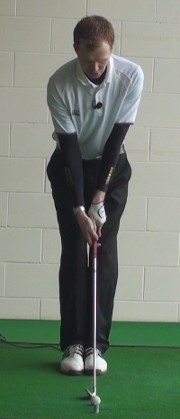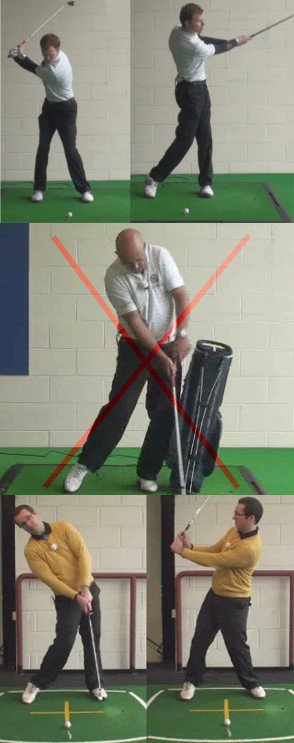
Want to lay the groundwork for a great golf swing? Improve your balance.
Poor balance is the culprit on many a mishit, causing contact on the toe and heel as well as thin and fat shots. Proper golf balance starts at address, of course, when your weight should be evenly distributed between the insteps (i.e. the balls and heels) of both feet.
If your golf swing is in balance, you'll finish with weight poised on your left foot. If that sounds unfamiliar, give this classic drill a try on the practice range. It can be used with any club, but starting with a wedge is advised:
1. Place the feet together, nearly touching, and hit shots with a smooth, three-quarters swing. Hold your finish to the count of three.
2. Continue until you can swing without tipping in any direction and consistently make solid contact.
Once you've achieved several balanced swings in a row, resume hitting balls with your normal stance and swing. You'll be amazed at how easily you retain steady balance from address to follow-through. (If you want to really test yourself, try hitting shots while standing on one leg.)
This drill also instills good rhythm, which goes hand in hand with good balance.
Poor Balance is the Culprit on Many a Mishits

When you mishit a shot, where do you place the blame? It seems that every golfer has his or her own pattern for deciding what went wrong during a swing. Some players like to blame outside forces – such as another player making noise during their swing – while others tend to assume that they weren't focused or had selected the wrong club. While there is any number of potential causes for a mishit, one of the leading issues is nothing more than poor balance. If you lose your balance during the swing, even slightly, it is going to be difficult to strike the ball solidly at impact.
We have two goals that we would like to accomplish in this article. First, we want to help you understand why balance is so important in the golf swing. If you gain a firm understanding of the importance of balance, you will be more likely to work on it regularly during your practice sessions. Our other goal is to provide you with the information you need to make progress with regard to your balance. Many golfers understand that balance is important, yet they don't know how to improve it moving forward. By the time you are done reading this article, we hope you'll have both the motivation and the tools necessary to solve your balance issues.
It should be noted that falling off balance only once in a while does not necessarily mean anything is wrong with your swing. Even the best golfers lose their balance from time to time, as this is a tough game and the golf swing is a complicated task. Trying to rotate your body at a high rate of speed while staying balanced is not easy, so it is going to go wrong on occasion. That's okay. It is only when you notice that falling off balance has become a recurring problem should you make a point of working on a fix.
All of the information below is written from the perspective of a right-handed golfer. If you happen to play left-handed, please take a moment to reverse the directions as necessary.
The Importance of Balance

There are some tips in golf that you hear so often they wind up going in one ear and out the other. This is certainly true when it comes to balance. You've probably heard over and over again that you should stay balanced as you swing, especially if you've ever taken a lesson from a golf instructor. But why is balance important? It seems that many people will tell you to stay balanced, but far fewer will bother to explain why it helps you play good golf.
Let's take a bit of time in this section to cover this topic. Please review the points below to see why balance is so important in your game.
- Clean contact. This is where everything starts when talking about balance. If you are not balanced during your swing, it is going to be nearly impossible to strike the ball cleanly with any kind of consistency. You'll run into a good shot from time to time, almost by accident, but ball striking is never going to be your strength. This comes down to knowing where the bottom of your swing is going to be each time you hit a shot. When you are balanced, the bottom of your swing will be consistent – so you will be able to match up that point with the location of the ball. That is not going to be so easy if you struggle with your balance. The bottom of your swing will move around to the left and right, and it will always be a guessing game when you try to strike your shots. If you have long been frustrated by your inability to make good contact, the path toward improvement almost certainly travels through better balance.
- Unleashing your power. When most golfers think about improving their balance, they think about making a controlled, conservative swing that will allow them to keep their weight in the center of their stance without any trouble. However, a balanced swing does not actually have to be the same thing as a conservative swing. In fact, some of the most powerful golfers in the world have built their swings on a platform of excellent balance. Think about it this way – when you have your balance under control, you will be free to swing as aggressive as you would like. You can 'turn it loose' since you know that your balance is going to hold you in position and help you to make a clean strike. Without balance on your side, you would have to hold something back in order to make sure you at least made decent contact with the ball. So, in the end, improving on your balance can actually be one of the fastest ways to add distance to your shots. Work on balance now, and once it has improved, go ahead and pick up the pace within your swing to see how far you can move the ball down the fairway.
- Predictable ball flights. There are many different ways to get the ball to the target in this game. Some players like to use a draw, while others like to use a fade. Some golfers like to hit the ball high, while others prefer to keep it down closer to the ground. The beauty of the game is that you aren't restricted to one kind of ball flight – you are free to use whatever pattern of shot helps you achieve the best results. With that said, you do need to be able to produce predictable ball flights if you are going to succeed. For example, it is possible to play well with either a fade or a draw, but you need to know which one you are going to use on any given shot. If you are surprised by your ball flights on a regular basis, you'll never be able to make improvements. Yet another benefit of balance is an improved ability to predict which ball flight is going to result from your swing. With your body consistently in the right position over the ball at impact, you can look up and expect the ball to be flying in roughly the pattern that you planned on when preparing for the shot.
The three points above are huge when it comes to building your game. If you can predict your ball flights, unleash your power, and make clean contact, the game will quickly become much easier. You stand to gain all of this simply by improving on your ability to stay balanced during the golf swing. Is it going to be easy to improve your balance? No – of course not. Nothing is easy in golf, and certainly not something as important as balance. However, you can make progress on this point with hard work and persistence, and you should start to see signs of improvement sooner rather than later.
Common Mistakes

Every golf swing is unique. When thinking about how you can improve your play, it is important to remember that no one else has your swing, so you need to tailor any instruction you receive to fit with how you swing the club. With that in mind, there are some common balance mistakes which are seen frequently in this game. If you take a moment to review the list below, there is a good chance that at least one or two of these issues is present in your current swing.
- Swinging too hard. This is a big one. Many of the balance problems in the amateur game come from nothing more than players trying to swing too hard. Yes, it is possible to swing hard while staying on balance – as we discussed in the previous section – but you have to start with balance and then add the speed. If you try to do it the other way around, by just swinging hard and hoping to stay balanced, the results are not going to be pretty. Golf is a game that is about precision first and foremost, so don't let yourself get too caught up in making the hardest possible swing in the hopes of maxing out your distance. Even as a short hitter, you can play excellent golf if you are able to control your ball properly. Once you learn how to control your shots, and you have your balance mastered, you can then work on picking up speed in the hopes of adding yardage. The sooner you can convince yourself that you don't need to swing so hard, the sooner you will be able to get your balance under control.
- Using too much lateral motion. The golf swing is a rotational action. We are going to repeat that sentence for effect – the golf swing is a rotational action. At the core of your swing should be a rotational movement, back away from the target and then forward through the ball. It is the turning of your body that provides power to the golf swing first and foremost. Unfortunately, many golfers seem to think that it is lateral movement more than rotation that is responsible for getting the job done. As a result, many players slide to their right in the backswing, only to attempt to slide left through the ball on the way down. While this may work once in a great while, it is never going to be consistent. Also, it is nearly impossible to generate meaningful power this way. In the end, it is the players who focus on rotation more than lateral movement who will be the best ball strikers. There is an element of lateral movement in a proper golf swing, but it only appears as a side effect of your rotation. Focus on rotation alone and the lateral part of the swing will take care of itself.
- Trying to help the ball into the air. During your next trip to the driving range, take a moment to step back away from the tee line and watch a few other golfers practice. When those players hit iron shots, there is a good chance that at least some of them – and maybe all of them – will be leaning back away from the target when their swing is complete. Why do they do this? Simple – they are trying to help the ball up into the air. Many new golfers struggle to get the ball off the ground, so they develop a habit of leaning away from the target to help the ball climb. Of course, this is not necessary, as your irons have loft built into the design of the club. As long as you make a clean strike with the club moving down through the ball, the shot should get up off the ground nicely without any trouble. It is important to avoid trying to help the ball up because this action can wreak havoc on your balance. As you swing down, you'll feel like you need to keep your body back to the right, so the club can 'scoop' the ball up off the ground. This is not the right way position to strive for, and a whole host of problems can result. To correct this issue, you simply have to trust that the loft of your clubs is going to do the job that it was designed to do. Hit down nicely and let the rest take care of itself.
There are plenty of potential issues that can come up with your balance during the golf swing, but the three listed above are extremely common in the amateur game. Think about the current status of your swing and decide whether or not any of the points above are giving you trouble.






